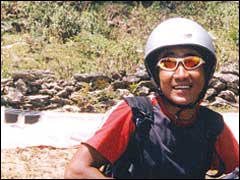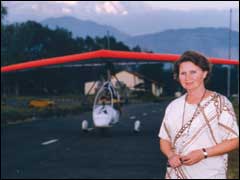 They say there are six directions in Nepal: north, south east, west, up and down. And one of the most vertical places in Nepal is Pokhara. From barely 700m above sea level, the terrain rises within 35km to the summit of Machapuchre at nearly 7,000m. Very few places on earth have such a perpendicular topography.
They say there are six directions in Nepal: north, south east, west, up and down. And one of the most vertical places in Nepal is Pokhara. From barely 700m above sea level, the terrain rises within 35km to the summit of Machapuchre at nearly 7,000m. Very few places on earth have such a perpendicular topography.
And yet, what Nepal has promoted so far is only a horizontal Pokhara with the lake and the reflection of the mountains on it. There is a whole new Pokhara that a lucky few have discovered: its air space. Today, almost by default, this tourist town is fast developing into a centre for aerial sports, as ultralights, paragliders, skydivers and freefallers take to the skies in growing numbers.
Ultralight
The pioneer was Avia Club Nepal which started taking tourists on microlights (hang-gliders with engines attached) for sightseeing flights from Pokhara airport in 1996. It was tough in the beginning: the project initially ran into turbulence as government agencies found one reason or other to block it. Natasha Shrestha, founder and director of Avia remembers those days well. "For two years were just doing proving flights and trying to convince the government it was a good idea, but finally we convinced them it would add to Pokhara's draw as a tourist destination," she recalls. Today, Avia gets full cooperation from the Civil Aviation Authority of Nepal and the Ministry of Tourism.
 Getting the operating license was the first hurdle, the second was ensuring that the seasonal flights would be a viable business proposition. But marketing efforts are finally paying off. Despite a tourism slump this year, Avia logged more than 210 hours of flights in its three ultralights this month-nearly five times the normal for this season.
Getting the operating license was the first hurdle, the second was ensuring that the seasonal flights would be a viable business proposition. But marketing efforts are finally paying off. Despite a tourism slump this year, Avia logged more than 210 hours of flights in its three ultralights this month-nearly five times the normal for this season.
At the hangar in Pokhara airport, Avia's brand new Russian-made tandem ultralight with side-by-side seating is getting ready for the first flight of the day. As the fog lifts, pilot Alexander Maximov, who is a Tupolev engineer in his spare time, guns the engine and asks Pokhara tower to taxi out. "Hotel Charlie, cleared to taxi out to runway 04," replies Debendra KC, air traffic controller at the tower, who by now, is used to the early morning flights of the microlights in his airspace.
The cockpit looks like a motorcycle, it even has a rear-view mirror. The only difference is that it also has an altimeter, vertical speed indicator and a compass. Maximov goes through the pre-flight check which involves nudging the control bar to see if the big kite-like wing above us is ok. Cleared for take off, the noise of the engine behind us rises to a whine, the craft hurtles down the runway and takes off effortlessly.  Pretty soon, Pokhara is hidden in haze and the Annapurnas rise up to the north in a gigantic wall of ice and rock. Maximov puts the craft on a slight bank over Phewa Lake, and we notice two other ultralights circling the Peace Stupa like dragonflies.
Pretty soon, Pokhara is hidden in haze and the Annapurnas rise up to the north in a gigantic wall of ice and rock. Maximov puts the craft on a slight bank over Phewa Lake, and we notice two other ultralights circling the Peace Stupa like dragonflies.
The plane is surprisingly easy to fly, push the bar down means you go up, push it up and you go down. Move it left, you go right and move it right and go left. It's opposite of flight controls on a big plane. Leveling off at 6,000ft, the twin peaks of Machapuchre heave into view: a more elegant and dignified peak is hard to find on this planet. You never get tired of looking at it.
At 45 knots, the speed is just right, and the wind chill factor isn't unbearable. As winter sets in, it is a good idea to wear a down jacket and gloves. This is just like riding a motorbike on a winter morning on the Ring Road, the only difference is that you are flying 4,000ft above the ground. We pass Sarangkot below us, and notice a Jomsom-bound Dornier has just taken off and is straining to get over Ghodepani Pass.
The descent is slow and smooth, no ears popping. We are cleared to land and swoop down towards the runway, the flare is quick and thrillingly close to the asphalt, followed by a slight squeal of tyres.  Natasha Shrestha's future plans are to expand the fleet of Avia's ultralights to include one with floats so pilots can use the lake to pick up passengers for sightseeing flights. She is running into some bureaucratic opposition to this idea, but she is used to that. Her son Stefan is now working on developing Pokhara as a venue for international ultralight championships. Avia has already become a member of the Federation Aeronautique Inernationale (FAI) and last year, it undertook the first-ever cross country ultralight flight in Nepal from Pokhara to Bharatpur and Meghauli. "If we can get cooperation from the government, Nepal will be a sought-after destination for ultralight championships," says Stefan Shrestha.
Natasha Shrestha's future plans are to expand the fleet of Avia's ultralights to include one with floats so pilots can use the lake to pick up passengers for sightseeing flights. She is running into some bureaucratic opposition to this idea, but she is used to that. Her son Stefan is now working on developing Pokhara as a venue for international ultralight championships. Avia has already become a member of the Federation Aeronautique Inernationale (FAI) and last year, it undertook the first-ever cross country ultralight flight in Nepal from Pokhara to Bharatpur and Meghauli. "If we can get cooperation from the government, Nepal will be a sought-after destination for ultralight championships," says Stefan Shrestha.
Mother and son also plan to turn Avia into a flying school for ultralights that will also draw foreign trainee pilots because there is nothing else like it in the region. Air sports groups involved in ultralight, paragliding and hot air balooning are also forming the Air Sports Association of Nepal to promote the industry.
Avia is also planning to start a Young Fliers Club on 17 December to commemorate the first flight by the Wright brothers 100 years ago to encourage young Nepalis to be interested in aviation. Avia\'s Deepti Gurung is working with schools to get students from Grade 8 and above to join in a programme that will include familiarisation of aviation concepts and an ultralight flight.
Ultralighting in Nepal may get a lot of publicity after the Bollywood blockbuster Love in Nepal starring Sonu Nigam comes out later this month. Avia's ultralights were used for shooting scenes in Pokhara.
Paragliding
Our next stop is Sarangkot, heading up in a jeep is a lot clumsier than flying, but we need to get up there so we can jump off the mountain on a paraglider. One of the pilots is another Russian named Ilya Milkov who is trained as a MiG-21 pilot in the Russian Air Force. We ask him a silly question: what is the pilot of an advanced supersonic jet doing riding thermals under a parachute in Nepal? Milkov is a man of few words: "It's fun."
Rajesh Bomjan and his brother, Binod, are two Nepali pilots licensed to fly paragliders. Rajesh takes his passenger through pre-flight instructions. (There is one embarrassing question about how much I weigh, which I deflect.) We go through tips on how to run downhill for the take off, then how to hit the ground running during landing at the bottom of the mountain.
So we sit in our hammock-like seats and start running like mad down the slope. Suddenly, without even realising it, we are airborne, held up by the updraft coming up Sarangkot. This is the closest one gets to real flying: no sound, just the rush of wind circling to catch the thermals. Rajesh takes the paraglider towards where he sees a group of griffon vultures soaring on the thermals. We go round and round just like the birds, rising all the while. Soon, we are about 500ft above the takeoff point, at eye-level with Sarangkot. Below us are the phosphorescent ripples on the lake, and beyond the ever-present massif of Annapurna South.
Unlike in the ultralight, here it is completely quiet, except for the rush of wind. Pilots shout to each other, and as we get closer to the ground we can even hear the sound of dogs barking and buses climbing the highway. The material in the parachute makes a rustling sound as we come in for a landing on a road on the banks of the Phewa, there is a final swoop and.yes.the eagle has landed.
Rajesh immediately unfastens my harness in case the wind picks me up again, he gathers up his sail and we go into the nearby Mayadevi Lodge for refreshments. Rajesh has adopted some raptors that he has trained to fly with him to guide paragliders towards thermals. They take three years to train, and a National Geographic film about 'para-hawking' in Nepal received honourable mention at the film festival in St Hilaire in France.
We ask Rajesh if he would ever like to be an airline pilot. He shakes his head: "This is real freedom, here you are face-to-face with nature, you have to know about wind patterns how they behave along mountain slopes, no two flights are the same." Rajesh has already logged 3,500 hours on paragliders and says there is enormous potential in Nepal to develop this sport. Pilots needs to have at lest 500 hours and a basic instructor's course before they are allowed to take passengers.
Ultralights:
Avia Club Nepal, Pokhara 061-525192
[email protected]
www.avianepal.21.bc.net
Paragliding:
Sunrise Paragliding, Pokhara 061-521174
[email protected]
Skydiving over Pokhara  Jorge, a Canadian of Venezuelan descent (right) has become the first person to make a freefall from an ultralight over Pokhara during a test flight on 19 October. The skydiver went up on an ultralight which climbed to 7,000ft above Pokhara, and once the pilot switched off the engine he jumped off freefalling for nine seconds before opening his parachute. On ground to receive Nepal's pioneer skydiver was the manager of Pokhara airport, Sagar Man Pradhan, and other dignitaries from the Civil Aviation Authority.
Jorge, a Canadian of Venezuelan descent (right) has become the first person to make a freefall from an ultralight over Pokhara during a test flight on 19 October. The skydiver went up on an ultralight which climbed to 7,000ft above Pokhara, and once the pilot switched off the engine he jumped off freefalling for nine seconds before opening his parachute. On ground to receive Nepal's pioneer skydiver was the manager of Pokhara airport, Sagar Man Pradhan, and other dignitaries from the Civil Aviation Authority.


